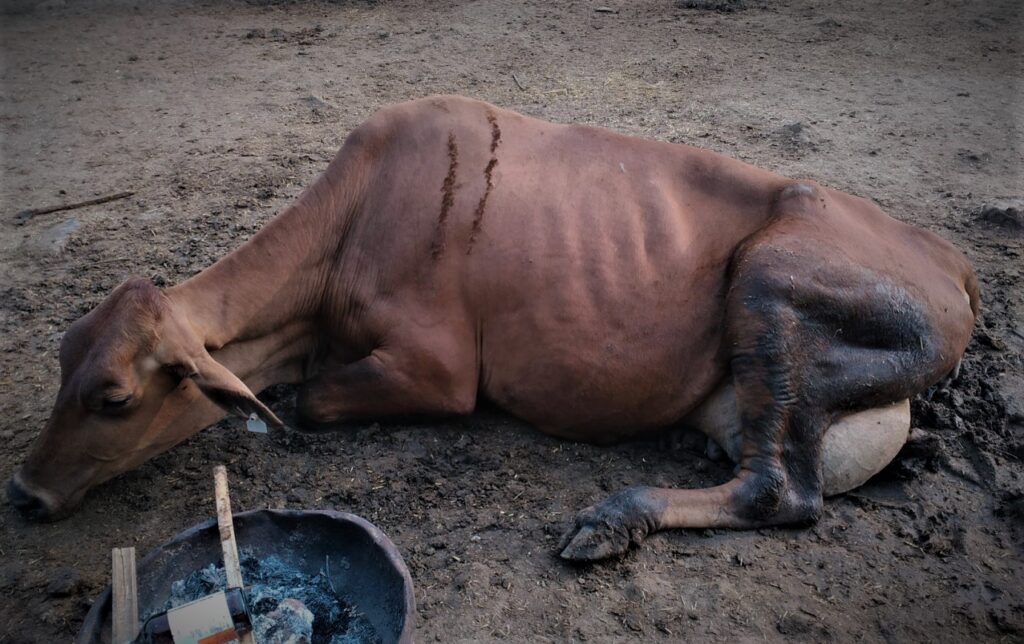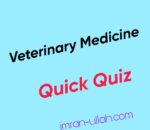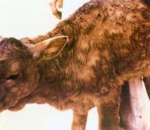Milk Fever is an afebrile, acute to peracute disease of female animals. It occurs at or within 72 hours of parturition in cows, buffalos, sheep, and goats. Milk fever is caused by hypocalcemia and is characterized by recumbency, generalized weakness, circulatory collapse, shock, and death. Milk is also known for its other names like Parturient Paresis & Hypocalcemia.
Milk fever mostly occurs in animals having 3rd and higher lactations. It is most common in high milk-yielding animals. Long-distance transport, digestive disturbance, and cold climate can act as predisposing factors for milk fever.
Etiology
During the early stages of lactation, animals secrete high levels of calcium in the production of colostrum. Each kg of colostrum contains about 2.3 grams of calcium in it. This secretion causes a drop in serum calcium levels. Serum calcium level decreases from 8.5—10.4mg/dL (normal value) to 2—6 mg/dL (animal suffered with milk fever). The sudden decrease in calcium causes weak muscle contractions and hyperexcitability of the nervous system. The deficiency of Vitamin D causes decreased absorption of calcium from the gut, and decreased resorption from bones also plays a role in the cause of milk fever.
Clinical Findings of Milk Fever
Depending upon clinical signs and observations, milk fever has three stages
Stage 1
- Temperature is normal
- Animal is hypersensitive & excited
- Mild ataxic (limbs are rigid)
- Tremors in the hind limb muscles
- Head bobbing
- Restlessness
- Bellowing
Stage 2
- Subnormal body temperature
- Animal is anorectic
- Dry muzzle
- Cold extremities and skin
- Animal is unable to stand
- Animal can sustain sternal recumbency
- Head is tuck into flanks or lateral kink of neck is visible.
- Anal reflex is not present
- Tachycardia on auscultation
- Animal is unable to defecate (Scant faeces) and urinate
- Weak pulse
- Weak heart sounds

Stage 3
- Marked subnormal temperature
- Severe bloat
- Lateral recumbency
- Animal behaves unconsciously
- Animal is unresponsive to stimuli
- Pulse is undetectable
- Heart rate approaches 120 bpm
- Animal goes into shock condition and dies within few hours if left untreated.
Diagnosis
- History of parturition
- Milk yield
- Typical clinical signs
- Clinical pathology (Low serum Calcium level)
- Treatment response to calcium therapy
Differential Diagnosis
- Toxic mastitis
- Toxic metritis
- Compartment syndrome (Calving paralysis syndrome)
- Traumatic injury (e.g., Coxofemoral luxation)
Line of Treatment for Mik Fever
Treatment is focused to restore normal serum calcium levels. IV use of calcium gluconate is the recommended treatment.
- Calcium borogluconate 1g/45kg – slow I/V
- Fluid therapy (Ringer’s lactate , DNS -10ml/kg)
- Vitamin A, D3, E&H 10-15 ml (I/M) in L.A.
- Antihistaminic like Avil 10 ml IM in L.A.
- Phosphorus injection
- Calcium chloride gel orally
Cautions:
Avoid intravenous administration of calcium solution with speed. Administer it only drop by drop while performing cardiac auscultation. The cardiotoxic effect of calcium causes bradycardia which leads to animal death.
Treatment for calcium-induced bradycardia:
- Atropine sulfate (0.02-0.2mg/kg)
- Magnesium sulphate –> 10% solution @100-400ml IV can also be used to protect against myocardial irritation.
Prevention of Milk Fever:
- Maintain a low calcium diet during last month of pregnancy. It stimulates PTH (parathyroid hormone) secretion which increases bone calcium release and intestinal absorption of calcium.
- Incomplete or partial milking after parturition.
- Administer SC calcium on the day of parturition or provide oral calcium.
- An IV or SC injection of Vitamin D (1 million IU/45kg) given to animal one week before calving is reported to be effective in prevention.
- Protect the animals from stress (cold, transport etc) near parturition.
Advice to farmers:
- After correcting the blood calcium level – avoid milking of animal and suckling of the calf for 3 days.
- Include calcium supplements in animal diet.


